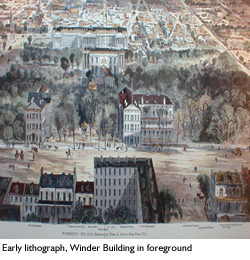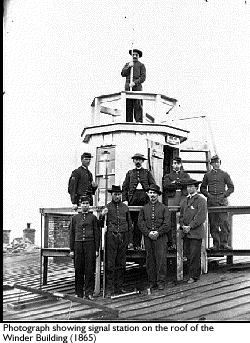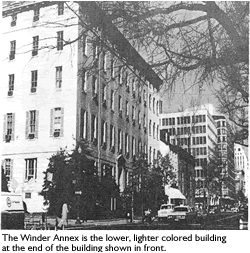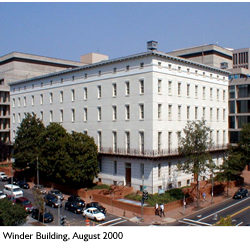The headquarters of the Office
of the United States Trade Representative are located in the Winder Building at
600 17th St., NW in Washington, D.C., a pre-Civil War building of
historic significance that  narrowly escaped demolition in an urban renewal city
program in the 1970s.
narrowly escaped demolition in an urban renewal city
program in the 1970s.
The Winder building, named after
its builder, William H. Winder, was Washington’s first “skyscraper” when it
opened for business in 1848. The government purchased the building in 1854 for
$200,000. Originally designed as office space for the U.S. Army and Navy, the
building has housed a variety of government tenants over the years, including a
military arms museum.
Around the time of the Civil
War, 1860-65, occupants of the Winder Building included the Quartermaster
General and the Navy's Bureau of Ordinance and Hydrography and later, the
Headquarters for the Bureau of Military Just ice under Judge Advocate General
Joseph Holt. In 1865, the Winder roof served as a signal station of the
Washington detachment of the U. S. Signal Corps for communication via flag
signals to military fortifications and camps around
Washington.
ice under Judge Advocate General
Joseph Holt. In 1865, the Winder roof served as a signal station of the
Washington detachment of the U. S. Signal Corps for communication via flag
signals to military fortifications and camps around
Washington.
In 1888, the building was
transferred to the Department of Treasury, which later built a cafeteria
restaurant for its employees in 1896. The Second Auditor of the Treasury and his
staff occupied the building exclusively for many years. During World War I, the
Army occupied part of the building. In 1949, the U.S. General Services
Administration, which is the building manager for many government facilities,
took control of the Winder Building and has maintained it ever since.
During the 1970s, the White
House used the building, which was undergoing renovation. At the end of the
Carter Administration, the Council on Wage Price Stability occupied the building
for a short time. USTR took up residence in 1981, moving from offices at 1800 G
Street, and before that in a building that is now the Eisenhower Executive
Office Building.
Architecture and history
The Winder Building has 60,000
square feet of floor space, 130 rooms on five floors with 104 windows. When
built, it was the tallest and largest office building in the District, measuring
75 feet in height and 210 feet in length on the F Street facade. The building
was constructed to be entirely fireproof with a pitched wooden roof sheathed in
sheet metal.
The Winder building was the
first in the city to use central heating and cast iron beams. While the central
heating system was a failure – Congress had to purchase dozens of stoves to
provide supplemental heat – the cast iron beams were an architectural
achievement. At one point in the building's early history, the roof blew off
during a storm, but the fourth and fifth floor tenants had no idea. Another
unusual detail is the wrought-iron tie, which is found at the corners and cross
walls of the building at every few rows of bricks, bracing the building
together.
 Three other buildings near the
Winder building shared some similar architectural elements. The Winder Annex was
the most noteworthy. Built in 1882, it was directly adjacent to the main
building on the left-hand side facing Seventeenth Street. The two buildings were
similar in style, and at one point they were connected. Next door to the annex
was Nichols Café, a federal-style townhouse built in 1830 that served both as a
restaurant and private dwelling. A third building, located on the corner of
17th and G streets, was built by the Washington Loan and Trust
Company in 1924. This bank later became part of Riggs National Bank in 1954
until it was vacated in 1965.
Three other buildings near the
Winder building shared some similar architectural elements. The Winder Annex was
the most noteworthy. Built in 1882, it was directly adjacent to the main
building on the left-hand side facing Seventeenth Street. The two buildings were
similar in style, and at one point they were connected. Next door to the annex
was Nichols Café, a federal-style townhouse built in 1830 that served both as a
restaurant and private dwelling. A third building, located on the corner of
17th and G streets, was built by the Washington Loan and Trust
Company in 1924. This bank later became part of Riggs National Bank in 1954
until it was vacated in 1965.
Brush with
destruction
In 1969, the Winder Building was
declared a landmark on the National Register of Historic Places, but the three
other buildings were excluded. At the time of its nomination and appointment to
the National Registry of Historic Places, the National Capital Planning
Commission described the Winder Building as “one of the few remaining pre-Civil
War office buildings in Washington, probably the earliest and least altered one
in existence.”
But despite the historic
designation, the General Services Administration announced plans to demolish the
Winder and the three buildings to make way for a new office building. A
citizen’s group, Don’t Tear it Down, Inc., filed suit in 1974 to prevent the
demolition. The Advisory Council on Historic Places sought to place the three
other buildings on the historic register, making it more difficult for GSA to
tear them down. GSA said it would not destroy the Winder building, and the
agency agreed to delay a decision on the other buildings until the matter was
submitted to a full council meeting.
But despite this promise, and
before legal status was confirmed, GSA began demolition of the buildings - on a
Sunday. Ultimately the case against GSA was dismissed as moot after GSA took
responsibility and apologized for its past actions. As mitigation for the
demolition of the other buildings, GSA allotted money toward the modernization
of the Winder building.
The renovations of the Winder
building were completed in 1976, and included air conditioning, heat, and
general ventilation. To satisfy the fire safety codes, the stairwells were
enclosed in glass and sprinklers were installed throughout the building. An
elevator room was added to the building (the older elevators had been in a
different location). Doors were restored to replicate the originals. The
intricate wrought iron balcony was restored. The original balcony, which ran
along the second floor, had been sold as scrap metal in
1922.
Myths
As with many old buildings,
there are a number of myths associated with the Winder building that add to its
mystique. It was once thought that during the Civil War, President Abraham
Lincoln would visit the Winder building to receive telegraphs about the progress
of the war from the southern and western battle areas as well as view military
parades from the building's exterior iron balcony. However, it is documented
that the telegraph machines were housed in the Telegraph Office of the Old War
building and that the military telegraph did not have even one line to the
Winder building.
Another unproven myth is that
Lincoln kept some of his horses and carriages in the stables behind the Winder
building. It is also believed that President Lincoln visited confederate
soldiers who were being held in a dungeon-basement inside the Winder building.
However, according to research, there was never a prison in the basement, nor
was anyone ever incarcerated in the building. Documents show only that civilian
suspects were questioned in the building's basement.
Another myth that has never been
proved is that four successive commanding generals of the Union Army (Scott,
Halleck, McClellan, and Grant) occupied offices in the Winder building. Yet most
generals during that time were headquartered in what was the Grant building on
the southwest corner of 17th and F Streets. Documents do show, however, that
following Lincoln's death, the building was the site of the entire investigation
surrounding his assassination, including the place where evidence was
amassed.
Without the famous inhabitants,
myths, and the beautiful, historic architecture, the Winder building would not
have as much significance as it does today. And while USTR, as its current
inhabitant, has begun to outgrow the building (recently housing some employees
in a building across the street), USTR is proud to be part of Winder's
history.

* * * *
*
Historical
Note: This document is intended to provide a general historical overview and,
thus, lacks source document citations. The Office of the U.S. Trade
Representative, however, does possess many of the source documents from which
this overview is derived.